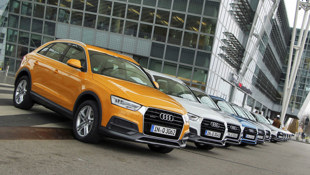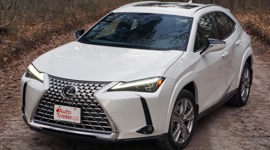Here’s an oddity for you. Before even getting a chance to review (or drive) the 2015 Audi Q3 now on the market here in Canada, we are bringing you this advance preview of the 2016 Q3, which receives a mild refresh and is coming to market next fall. That’s a long way off, but the changes relevant to our market are incredibly subtle, so this is a great point to begin our coverage of the Q3, which is beginning to take the Canadian market by storm.
Although just released in Canada this fall as a 2015 model, the Audi Q3 has been on the European market for several years now, and is a resounding success with over 400,000 units sold to date globally. In Canada, it got out of the gate a month before the Mercedes-Benz GLA, its primary competitor, and is outselling that mini-ute so far in their first couple months – that is a sales battle we will continue to follow with avid interest. It also has an edge on the established X1 from BMW in those same months, but it’s hard to make too much of it with Q3 supply likely not yet keeping up to demand.
The Q3 is a truly compact crossover, its footprint no larger than a Toyota Corolla or Honda Civic (actually, it’s quite a bit shorter in length, but wider), but it has much of Audi's modern design ethos wrapped into a tight package.
Anyhow, the vehicle itself: the 2016 Q3 receives a mild facelift and interior upgrades, though there are also a range of updates to various European powertrains. The sole powertrain option in North America, the familiar 2.0TFSI turbocharged gasoline engine remains paired with a tiptronic automatic transmission and choice of front- or all-wheel drive.
Like the specifications, price is unlikely to change much, if at all, currently starting at $35,800 for a base FWD Progressiv model to $40,900 for the top Quattro Technik trim, with various options available to take the price up to the mid-40s.
The Q3 is a truly compact crossover, its footprint no larger than a Toyota Corolla or Honda Civic (actually, it’s quite a bit shorter in length, but wider), but it has much of Audi's modern design ethos wrapped into a tight package. With stubby proportions, it also has a certain element of fun to it, but a touch of chrome around the windows and metallic roof rails keep it classy.
The front is where we will see the most distinct changes, with a more pronounced angular grille shape surrounded in chrome that reaches out to the headlights at the top. Those headlights are also updated with Audi's clean straight lines and kink in the housing and wraparound LED accents that give it a strong visual signature at night.
At the back, the design changes are even more subtle, again with new lighting design and more horizontal creases in the bumper to emphasize its width and twin tailpipes finishing the underbody diffuser. The redesigned taillights don't just look modern and slick, they also feature a neat little party trick: the individual LEDs in the turn signal indicator illuminate from the inside to outside, clearly identifying the intended directional change. It remains to be seen if this and the stuttering brake lights to indicate panic braking will be fitted to North American models.
Always an Audi highlight, the Q3 interior is thoroughly modern, and although more basic than its larger siblings, still features superior quality to anything this size. However, the design itself is a bit of a mixed bag, the leaning vents and asymmetrical effect it creates are not my favourite Audi design.
The steering wheel, especially as in this S-Line Package model is a feast for the hands, with perforated leather, thick, tight stitching and contoured grips. The buttons on the left spoke control Audi's interface and those on the right spoke volume, voice command and a programmable 'favourite' button. Behind the wheel are bright, clear gauges, and an extra information screen in the middle that can display a digital speedometer or a variety of other information like efficiency, music, phone contacts and vehicle settings.
Our driving route took us on a short loop out of Munich's airport on a stretch of autobahn and through some rural farmland with just a few twists and turns to shake it down.
The Q3 is planted and solid on the highway, with steady steering and firm ride control, but there is no question that it is designed with the city in mind. The high vantage point and good visibility to the front and sides make it easy to navigate tight quarters.
The only engine on offer in Canada is the 2.0L direct injected turbocharged four cylinder. Our market will soldier on with the current 200 hp and 207 lb-ft of torque; the 2016 power ratings for European models rise to 220 hp and 258 lb-ft of torque, paired with a dual-clutch S tronic gearbox as on our A3 2.0TFSI.
What we drove was the Euro-spec model, and with 258 lb-ft available from 1,500 through 4,400 rpm, there is plenty of grunt to get going, and its peak 220 hp reached at 4,500 rpm keep things exciting right up to 6,000 rpm. However, with a curb weight of 1,565 kg as configured (1,585 and 1,670 for Canadian FWD and AWD models), power isn't felt dramatically, more of a slow build, and but it is there for the taking and it got us up to autobahn merging and passing speeds quick enough to instill confidence in at any speed. With a more modest 200 hp at 5,100–6,000 rpm and torque limited to 207 lb-ft from 1,700 to 5,000 rpm, Canadian spec cars might be even less eager to get going, as evidenced by their acceleration times for FWD and AWD models: 8.2 and 8.6 seconds to reach 100 km/h, respectively.
The transmission will remain Audi’s six-speed automatic, which has its benefits and drawbacks. The Audi S tronic dual-clutch gearbox now offers seven speeds, and quick, crisp shifts. But like the A3’s S tronic, it still suffers from some low-speed hesitation, which the automatic handles better.
Power is coupled to either front-drive in base trim or Quattro all-wheel drive for sure traction in all conditions, and the automatic is the only transmission selection available.
As mentioned earlier, the Q3 is small, 4,388 mm in length and a wheelbase of 2,603 mm. Priority in interior space is given to front passengers, with lightly bolstered and comfortable S-line seats available in black, grey or brown.
As is to be expected from a crossover this small, rear seat legroom is limited, but an average adult can still fit semi-comfortably, and child seats should be easy to install at a height that's easy on the back. Cargo space is rated at 460 L with the seats up, plus a handy pass-through and 60/40 split-folding rear seats that yield a maximum of 1,365 L. It is also finished in carpet with a cargo net to keep small parcels from sliding around.
Because when you find a stretch of open road and curves, you will want to press it. The front suspension features McPherson struts with aluminum lower wishbones mounted to an aluminum subframe with tubular anti-roll bar and track-stabilizing steering roll radius. The four-link rear suspension is complemented by separate spring/shock absorbers, aluminum wheel carriers and tubular anti-roll bar, and front and rear work together to provide surprising range of capability.
The Q3 rides firmly, but still manages to subdue bumps well for such a short wheelbase car. Helping the cause of our test vehicle were fairly high-profile 235/50R18 tires on 18-inch rims, which soak up much of the harshness from small road imperfections. Overall, though, preference is given to a sporty ride, and the Q3 turns in nimbly and suppresses body roll well for such a tall, small vehicle, and with Audi's well-sorted steering, it's quite fun to chuck it into turns, where it rewards with confidence. Just keep it within reason – it is just a small SUV after all, not a sports car.
The Q3 is more suited to the daily crawl into work or mall runs with the squirts, or even road trips with the family, where the high-res nav system and intuitive interface make it easy to enter a destination or pick tunes. However, in this layout, the dash-mounted controller is not as ergonomically friendly as Audi's usual console-mounted position. Dual-zone climate control and seat heaters ensure optimal temperature and toasty buns. Those functions are controlled by simple, easy-to-use dials and buttons.
Meanwhile, over in Europe, Audi offers a selection of up to 11 powertrains, with a variety of diesels and gasoline turbos and manual or automatic transmissions... and a tent. We tried the base 2.0L diesel, and as efficient as it might be, it was a tad sluggish for our tastes.
Another model available for testing was much more to our liking. We've sampled it before in a better testing environment (the Alps!), but the RSQ3 impressed again, and like the standard Q3, boasts upgraded interior trimmings and design.
The RSQ3 is a stunning package, the wheels upsized to fill the arches, more aggressive bodywork and gloss black accents replacing the chrome to give it an extra helping of aggression. Those upgraded wheels are 20-inchers wrapped in 235/35R20 Pirelli performance rubber and peeking through them you can see the 8-piston fixed-caliper front brakes that clamp down on 365 mm perforated, ventilated, rotors with wave technology; at rear single-piston floating calipers restrain 310 mm rotors.
The engine is a turbo 2.5L five-cylinder that lists 340 hp at 5,300 to 6,700 rpm and 332 lb-ft of torque from 1,600 to 5,300 rpm. This kind of torque gives you a good shove in the back at launch, and the power keeps climbing, as evidenced by my top speed of 240 km/h on an unrestricted section of the autobahn.
Power in the RSQ3 is routed through a seven-speed dual-clutch S tronic transmission and distributed to all four wheels through Quattro all-wheel drive. It puts power down effectively, and manages gear changes quickly and sharply, with a Sport mode for cranking up the aggression factor even more.
As with any Audi product tuned by Quattro GmbH, their tuning and racing arm, the RSQ3 is fairly heroic in its capabilities, and in this instance it is surprising given the mundane roots of a small crossover. It is a massively fun car, but has all the basic practicality of the Q3 and a spicy flavour that we think many here would appreciate.
I think Canadian customers would also appreciate the subtle improvements made to the European-spec 2.0TFSI powertrain, the increased efficiency and improved performance of the S tronic transmission, especially looking across the showroom at the smaller, lighter A3 sedan with that output and a six-speed dual-clutch. In fact Audi offers three engine options for the A3 sedan (four if you count the S3), and with the popularity of small crossovers in North America, greater choice would only benefit customers and likely sales.






























